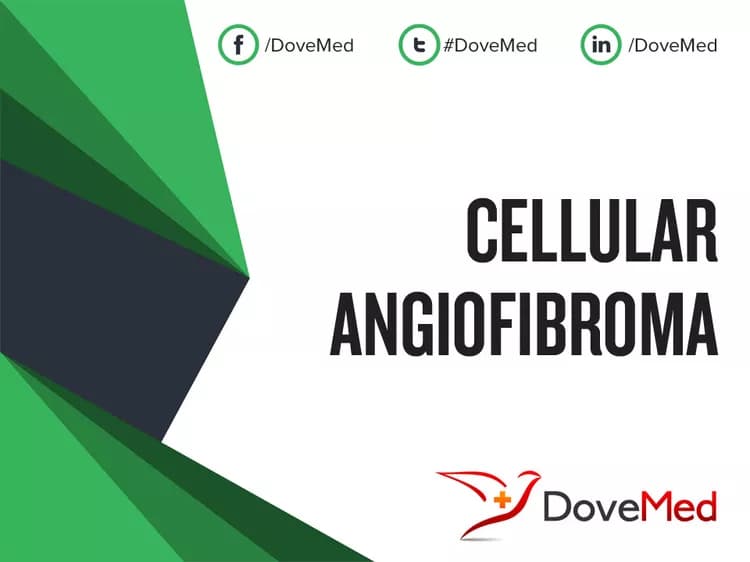What are the other Names for this Condition? (Also known as/Synonyms)
- CA (Cellular Angiofibroma)
- Male Angiomyofibroblastoma-Like Tumor
What is Cellular Angiofibroma? (Definition/Background Information)
- Cellular Angiofibroma (CA) is a rare, benign soft tissue tumor that is seen to originate below the skin in the pelvic region in adults i.e., the vulva in women and near the scrotum/testis in men
- Cellular Angiofibroma tumors are mostly seen in middle-aged and older adults. Some study reports indicate that certain hormonal factors may play a role in the formation of these tumors
- Cellular Angiofibromas are generally painless and may remain undetected due to a lack of significant signs and symptoms. However, some are known to grow to large sizes and cause pain and compression of adjoining organs
- The treatment of choice is a surgical removal of the entire tumor. The prognosis of Cellular Angiofibroma is excellent with appropriate treatment
Who gets Cellular Angiofibroma? (Age and Sex Distribution)
- Cellular Angiofibroma is generally present in middle-aged and older adults. The tumor is observed both in males and females at an equal incidence rate
- Most tumors occur in men in the age group 60-70 years; while in women, most tumors are seen between 40-50 years
- In general, Cellular Angiofibroma may be found in individuals in the 20-77 year age category with an average age of 46 years
- There is no geographical, racial, or ethnic preference noticed
What are the Risk Factors for Cellular Angiofibroma? (Predisposing Factors)
- No specific risk factors are evident for Cellular Angiofibroma
- It is believed that certain hormones (such as estrogen and progesterone) may play a role in tumor development
- The condition may be associated with hernia (bulge) or hydrocele (fluid-filled testicular sac) in men
It is important to note that having a risk factor does not mean that one will get the condition. A risk factor increases ones chances of getting a condition compared to an individual without the risk factors. Some risk factors are more important than others.
Also, not having a risk factor does not mean that an individual will not get the condition. It is always important to discuss the effect of risk factors with your healthcare provider.
What are the Causes of Cellular Angiofibroma? (Etiology)
The exact cause of Cellular Angiofibroma occurrence is unknown.
- Some research studies indicate that the tumor formation may occur due hormonal factors. The hormones that are involved include estrogen and progesterone
- Cellular Angiofibroma is also shown to be closely related to two benign tumors, namely mammary-type myofibroblastoma and spindle cell lipoma, on tumor cell genetic study
Currently, research is being performed to understand the relevant causative factors.
What are the Signs and Symptoms of Cellular Angiofibroma?
The signs and symptoms of Cellular Angiofibroma include:
- Cellular Angiofibromas are slow-growing soft tissue masses; they can have a rubber-like consistency to touch
- The tumors are spherical or oval in shape, well-circumscribed but with poorly-defined boundaries
- In men, occasionally they can infiltrate the surrounding tissues
- Most tumors form below the skin in the pelvic or groin region; the vulva in women and scrotum/testis in men may be affected
- The tumor size can range from 6 mm to as large as 25 cm; in men the average size is around 7 cm, while in women it is about 3 cm
- Mostly these tumors appear as painless masses, due to which these are usually detected incidentally. Large-sized tumors may cause pain and compress surrounding structures and organs
- Other tumor locations, in rare cases, include the retroperitoneum (abdominal cavity), around the upper thigh and buttocks (lower back), mucus membranes of the mouth, knee, and even the upper eyelid
How is Cellular Angiofibroma Diagnosed?
Cellular Angiofibroma diagnosis may involve the following tools:
- Complete physical examination with thorough evaluation of medical history
- Ultrasound, CT, MRI scans of the affected region
- Tissue biopsy: A tissue biopsy is performed and sent to a laboratory for a pathological examination, who examines the biopsy under a microscope. After putting together clinical findings, special studies on tissues (if needed) and with microscope findings, the pathologist arrives at a definitive diagnosis
Note: The tumors may be initially misdiagnosed as Bartholin’s cyst prior to a tissue biopsy.
Many clinical conditions may have similar signs and symptoms. Your healthcare provider may perform additional tests to rule out other clinical conditions to arrive at a definitive diagnosis.
What are the possible Complications of Cellular Angiofibroma?
The possible complications of Cellular Angiofibroma include:
- Emotional stress and concern, especially with tumors in the genital region
- Tumor recurrence following surgery is known to take place in rare cases
- Damage of vital nerves, blood vessels, and surrounding structures, during surgery to remove the tumors
How is Cellular Angiofibroma Treated?
Following are the treatment methods adopted for Cellular Angiofibroma:
- The healthcare provider may recommend a ‘wait and watch’ approach for small-sized tumors presenting mild signs and symptoms
- Complete excision and removal of the tumor is normally sufficient treatment
- Follow-up care with regular screening and check-ups are important, since the tumor can recur in some cases
How can Cellular Angiofibroma be Prevented?
Current medical research has not established a way of preventing Cellular Angiofibroma.
What is the Prognosis of Cellular Angiofibroma? (Outcomes/Resolutions)
- The prognosis of Cellular Angiofibroma is generally excellent on surgical excision and removal of the tumor. It is a benign tumor with very little risk of recurrence
- Malignant transformations of Cellular Angiofibromas have not been observed
- However, periodic follow-up check-ups with screening may be required
Additional and Relevant Useful Information for Cellular Angiofibroma:
Please visit our Cancer & Benign Tumor Health Center for more physician-approved health information:
Related Articles
Test Your Knowledge
Asked by users
Related Centers
Related Specialties
Related Physicians
Related Procedures
Related Resources
Join DoveHubs
and connect with fellow professionals


0 Comments
Please log in to post a comment.